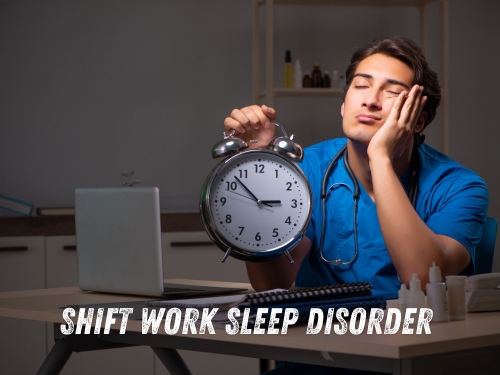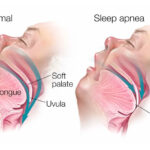Shift Work Sleep Disorder (SWSD) is a circadian rhythm disorder that arises from a misalignment between an individual’s biological clock and their work schedule. It primarily affects those who work night shifts, rotating shifts, or early morning shifts. One of the most prevalent and disruptive symptoms of SWSD is excessive sleepiness during waking hours, which can undermine cognitive performance, health, and safety.

The Circadian Misalignment Behind Shift Work Sleep Disorder
Human physiology is designed around a 24-hour circadian rhythm, which governs sleep-wake cycles through the regulation of melatonin and core body temperature. In individuals with SWSD, this rhythm is continually disrupted due to:
- Night or rotating shift schedules
- Inconsistent sleep timing
- Exposure to light during nighttime hours
- Insufficient total sleep duration
The resulting mismatch between internal clock and external demands prevents restful sleep during off-hours and causes persistent daytime or night-time sleepiness, depending on the schedule.
Key Symptoms: How Sleepiness Manifests in SWSD
The primary symptom of SWSD is excessive sleepiness at inappropriate times, typically during work hours or socially active periods. This symptom persists for at least one month in affected individuals and is distinct from general fatigue.
Common symptoms include:
- Difficulty staying alert during shifts
- Unrefreshing or fragmented sleep
- Difficulty falling asleep post-shift
- Headaches and mood disturbances
- Reduced reaction time and decision-making ability
- Impaired work performance and increased error rates
Who Is Most at Risk?
Certain occupations and work patterns heighten the risk of developing shift work sleep disorder:
- Healthcare workers
- Emergency responders
- Transportation personnel (e.g., pilots, truck drivers)
- Manufacturing and factory workers
- Security personnel
- Rotating shift workers (changing shifts every few days)
Younger workers and those with longer commutes are particularly vulnerable to severe sleepiness and its consequences due to increased sleep debt.
Physiological Consequences of Shift Work-Induced Sleepiness
Chronic sleepiness from SWSD contributes to a cascade of physiological impairments:
- Reduced REM and deep sleep leads to poor cognitive restoration
- Impaired glucose metabolism raises risk of Type 2 diabetes
- Elevated cortisol levels promote chronic stress and weight gain
- Cardiovascular risks such as hypertension and increased stroke risk
- Weakened immune function leading to higher infection rates
Additionally, shift workers with SWSD face a significantly higher risk of motor vehicle accidents due to drowsy driving.
Diagnostic Approach to Shift Work Sleep Disorder
Diagnosis of SWSD is clinical and may be supplemented with objective tests to rule out other sleep disorders.
Diagnostic Criteria (per ICSD-3):
- Presence of a recurring work schedule that conflicts with normal sleep hours
- Symptoms of insomnia and/or excessive sleepiness for at least 3 months
- Sleep log or actigraphy confirming disturbed sleep patterns
- Absence of other underlying medical or psychiatric sleep disorders
Tools and Tests:
- Sleep logs or diaries over two weeks
- Actigraphy to monitor rest-activity cycles
- Epworth Sleepiness Scale (ESS) for quantifying daytime sleepiness
- Polysomnography when comorbid disorders like OSA are suspected
Evidence-Based Strategies to Manage Shift Work Sleepiness
Managing sleepiness in SWSD requires a structured approach combining behavioral, environmental, and pharmacologic strategies.
Sleep Scheduling and Napping
- Establish a regular sleep-wake routine, even on days off
- Use anchor sleep periods (e.g., fixed 4-hour core sleep) after night shifts
- Incorporate strategic 20–30-minute naps before or during shifts to reduce sleep pressure
Light Exposure Control
- Bright light exposure at the start of night shifts helps delay melatonin release
- Wearing blue light-blocking glasses on the commute home aids in melatonin production
- Blackout curtains and eye masks during daytime sleep promote darkness and melatonin secretion
Pharmacologic Aids
- Melatonin supplements (0.5–3 mg) taken before daytime sleep can promote quicker sleep onset
- Caffeine used strategically during shifts enhances alertness without disrupting sleep when avoided post-shift
- Modafinil or armodafinil, prescribed stimulants, may reduce excessive sleepiness but should be used with medical supervision
Behavioral Interventions
- Cognitive Behavioral Therapy for Insomnia (CBT-I) adapted for shift workers improves sleep hygiene and reduces anxiety about sleep
- Education and training for employees and supervisors on managing fatigue and shift scheduling
Long-Term Solutions and Workplace Policies
Sustainable management of SWSD also involves systemic changes in work environments:
- Forward-rotating shifts (day → evening → night) are better tolerated than backward-rotating schedules
- Limiting consecutive night shifts to fewer than 3 improves recovery
- Allowing nap breaks and rest facilities on-site reduces risk of errors and accidents
- Flexible scheduling options accommodate chronotypes (morning vs evening people)
Frequently Asked Questions:
How long does it take to adjust to night shifts?
It may take 7–10 days for the circadian rhythm to adjust to night work, though some individuals never fully adapt.
Can shift work sleep disorder go away on its own?
Without schedule changes or interventions, SWSD symptoms typically persist and can worsen over time.
Is melatonin safe for long-term use in shift workers?
Short-term use of melatonin is generally safe. Long-term safety should be evaluated with a healthcare provider.
Can shift workers ever sleep “normally”?
Yes, with structured routines, light management, and behavioral interventions, shift workers can achieve restorative sleep.
What’s the difference between general fatigue and SWSD?
SWSD specifically involves chronic misalignment of the sleep-wake cycle due to work schedules and is diagnosable; general fatigue may have broader causes.
Sleepiness due to shift work sleep disorder is a serious health and safety issue rooted in circadian misalignment. Left unaddressed, it can lead to physical illness, reduced work performance, and even fatal accidents. Through a combination of strategic sleep management, light control, behavioral modification, and institutional policy support, affected individuals can significantly improve their alertness, health, and overall quality of life.

